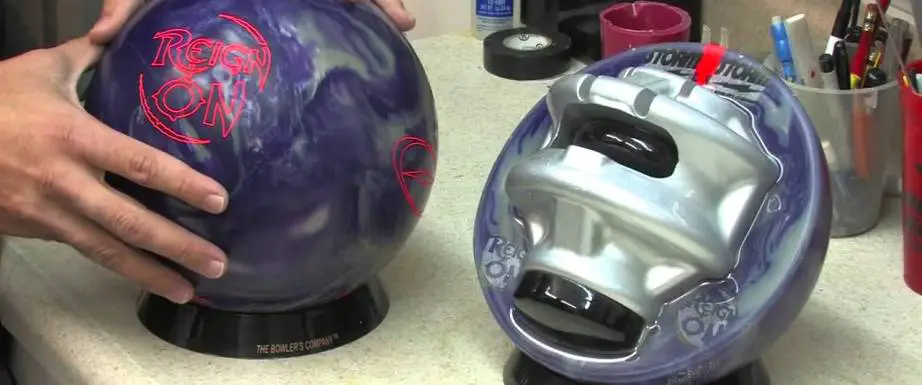
Ever wonder what RG in bowling is?
Ever wonder why a bowling ball’s RG is important or how to interpret it?
Like many avid bowler’s it took me years to finally become curious enough to investigate the topic, problem for me was that all the physics involved with bowling are just so complicated that it was just easier to try and throw my ball to the right spot every time.
As it turns out, eventually you get good enough that getting a ball to certain spot on the lane just isn’t good enough, you have to get the ball to a certain spot, at the right speed, with the intended trajectory, and with the correct amount of retained energy at the break-point to carry strikes consistently.
RG, as complicated as it sounds, makes a big difference in ball motion on the lanes and choosing your equipment based on these specs can make a big difference in improving your pin carry, especially on demanding conditions.
What is RG in Bowling Anyway?
Every bowling ball has a core otherwise known as the weight block.
The weight block accounts for most of the weighty mass of a bowling ball and it’s not shaped like a sphere either.
Many weight blocks are shaped like a light bulb, an oval, a football, or some other symmetrical (or nearly symmetrical) shape that is slightly taller than it is wide.
*I’ll reserve the distinction between asymmetrical balls and symmetrical balls for another day.
At the top of taller orientation of the core is the pin. The pin extends up from the core through the coverstock to the surface of the ball. It serves as a visual indicator of the top of the core.
The pin is also an indicator for the balls low RG axis, sometimes referred to as it’s X-axis.
In laymen’s terms this is the axis line that the thinner width of the core rotates around just like a football rotates when it is thrown with a tight spiral.
On a bowling ball’s spec sheet the RG number that is typically advertised is the RG value for the X-axis, the low RG measurement of the ball.
RG is an abbreviation for radius of gyration or the radius of the core while it’s spinning.
A football thrown as a spiral will have a smaller radius than a football spinning end over end.
The end over end rotation of the core has a longer radius which means the axis it rotates around is perpendicular to the pin (x-axis).
Obviously on a football the two radius measurements are significantly different. The low RG radius is much shorter than the high RG radius.
In a bowling ball the USBC has required all balls have a low RG no shorter than 2.46 inches and the high RG can be no longer than 2.8 inches.
If you were to create a spherical core that was 2.46 inches wide and 2.8 inches tall it would look like a perfect sphere on first glance although upon close inspection you would be able to tell that it was actually a slightly “squished ball”.
Under these restrictions the skinny side of the core can be no more than 12.4% skinnier than the wide orientation of the core which would be hard to notice on a passing glance… except the USBC has even more restrictions on the core which make the difference in width vs height of the core even harder to perceive.
The difference in core width vs height (this is called differential) is regulated to be at maximum 0.06 inches by USBC rules meaning the skinny side of the core can actually be no more than 2.1% skinnier than the wide orientation!
That is a crazy small measurement that no one would ever notice by just looking at the core but it is all that’s needed to make a meaningful difference in ball motion down lane when the ball is spinning at 350 rpms.
So that’s what RG means in a bowling ball… but what exactly does that mean? Or rather, why does all that matter?
Why RG in a Bowling Ball Matters
When a bowling ball is rolling down the lane around it’s low RG axis (like a football spiral) it is spinning in a very stable position and the core will help the ball read the lane sooner.
A low RG induces earlier roll, smoother arcing hooks, and less retention of energy for the end of a bowling lane or the oil pattern.
On the other hand if you were to roll the ball down the lane over its other stable axis point, it’s high RG axis (think end-over-end football) then the core would cause the ball to read the lane later. The ball would enter its hook phase closer to the end of the pattern or past it and it would react more abruptly to friction.
High RG balls will use less energy in the heads and mids reserving more of it for the backends.
Lets Now Confuse Things a Bit and Talk Briefly About Differential and PAP
So let’s say you are looking at a ball that has a very low RG. You would expect this ball to hook early and have a wider arc through the break point.
If however the difference in width between it’s low RG axis and it’s high RG axis is big then the ball has the potential to flare more than a ball where the difference is small.
When you see differential advertised on a ball they are talking about the difference between the high RG and low RG widths of the core.
When the differential is large the ball has the potential for a lot of track flare (more overall hook) and when the differential is small the ball has the potential for much less track flare (less overall hook).
To further muddy the water a ball with a high differential may have the potential for a lot of flare but depending on the layout of your gripping hole placements you can you may drill the ball so as to minimize the track flare to near zero.
In short, a ball with low differential will always minimally flare but a ball with high differential can be drilled to either flare a lot or a little which will greatly change the amount of potential hook for that particular ball.
Its up to you and your driller to determine how much flare you want and this is typically dictated by the placement of your PAP in relation to either the high RG axis or the low RG axis (the pin and the mass bias).
If the drilling of your ball places your PAP on top of or very close to the ball’s low RG axis then the ball will barely flare and will read the lane early and weakly regardless of the amount of differential.
The ball will simply roll down the lane spinning around the smaller core radius like a football in a tight spiral.
If your drilling places your PAP on top of or near your high RG axis point then the ball will barely flare. It will read the pattern further down the lane and the change of direction will be weaker than it would be if drilled in a strong position that places your PAP significantly between the two RG axes.
Basically a ball’s differential specs are only meaningful if you want to make a ball as aggressive as possible.
No matter what the differential is however the high and low RG specs allow you and your driller the ability to choose whether a ball will read the lane somewhat earlier on the lane or further down lane.
Considering the fact that all of this is based on the placement of your PAP in relation to the two perpendicular axes it’s obvious that you need to have a good idea as to where your PAP is on the ball to fine tune ball reaction when deciding on a drilling layout.

